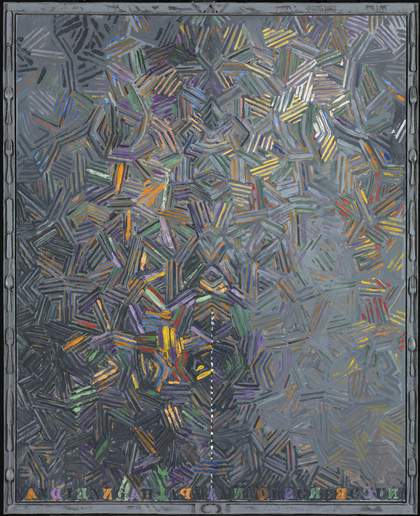
Fig.1
Jasper Johns
Dancers on a Plane 1980–1
Tate T03242
Prior to serving any other purpose, the frame placed around a picture provides a context, a signifying framework, which designates it as a work of art: as Painting. Yet the heavy bronze frame Jasper Johns constructed for his Dancers on a Plane 1980–1 (Tate T03242; fig.1) seems to exceed this function. In its idiosyncratic obtrusiveness, its disproportionate ornamentation and mass, the significance of the painting’s frame overflows its own semiotic boundaries. In consequence, it is not merely the painting that is framed, but everything that the latter might be said to contain: the history that it isolates and condenses.
In her essay in this In Focus entitled ‘The Painting and the Frame’, art historian Katherine Markoski suggests that this feature of Dancers on a Plane testifies to the interest Johns took in the framing of his work in the years following his 1977 Whitney Museum retrospective. This essay will attempt to outline some of the ways in which Dancers on a Plane more specifically frames the preceding decade of Johns’s production, which was largely dedicated to the exploration of a single motif: the hatchings. With Dancers on a Plane, it could be said, Johns sought to ‘frame’ this phase of his career by delimiting its beginnings and endings, distinguishing it from earlier and later phases while situating it within the larger context of his oeuvre. The formal and thematic shifts and reversals that characterise Johns’s elaboration of the hatching motif are at least partially and provisionally reconciled in this work, even as Dancers on a Plane points the way towards the next stage of Johns’s production. But in order to understand this, it will be necessary to review the history of this motif’s
introduction into Johns’s work, and consider how its significance
changed over time.
By the mid-1960s Jasper Johns was an established and highly collectible artist, whose art market success was predicated upon his work’s assimilation to the criteria of traditional connoisseurship. Meanwhile, a new avant-garde had emerged onto the New York art scene. Caught between the dematerialisation of the object in conceptual art, and the return to expressionism in process art and post-minimalism, Johns sought to demonstrate the continuing relevance of his work by forging strategic alliances within it that played one tendency off against the other. Over the course of the 1970s, even as he confined himself to a limited repertoire of processes and motifs, Johns constantly shifted stylistic gears, aligning his work first with conceptualism against the process-based art of Jackson Pollock and post-minimalism, and then with surrealism and Picasso against the postmodernist ‘death of the author’. In his hands, conceptual art’s systematic investigation of the logical operators of drawing and painting – line direction and colour – took on thematic significance as a reflection of Johns’s own changes of artistic direction. From the very first works to incorporate hatchings from around 1974, stylistic change and artistic development were analogised to the image of the body in movement; in the culminating Dancers on a Plane (1979–82) and Tantric Details (1980–1) series of works, shifts in stylistic allegiance were compared to the exchange of partners in two particularly charged configurations of bodies – dance and sex. It will be argued here that in exploring the relationships among these terms, Johns confronted the threats posed by influence and appropriation to the unity of the artist’s oeuvre.
Untitled 1972 and Scent 1973–4: The double birth of a motif
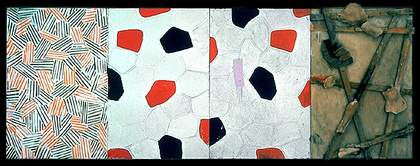
Fig.2
Jasper Johns
Untitled 1972
Oil paint, encaustic and collage on canvas with objects
1830 x 4900 mm
Museum Ludwig, Cologne
© Jasper Johns
The first work by Johns to feature the hatching motif is Untitled 1972 (fig.2), a massive, four-panel work whose leftmost section displays an all-over pattern of hatchings in orange, green and purple. The right-hand panel is crisscrossed by wooden bars to which the artist affixed fragmentary plaster casts of body parts, while the two central sections feature a repeating pattern of flagstone shapes painted red, white and black. The right-most panel clearly evokes Johns’s previous use of casts, beginning with his Target with Plaster Casts of 1955 (Leo Castelli Gallery, New York), while the two middle panels quote the flagstone motif Johns first used in Harlem Light 1967 (Seattle Art Museum, Seattle), based on a flagstone-painted wall the artist had noticed while driving through Harlem in New York.1 The left-hand panel contains the only new element, the hatchings, which Johns based on a glimpse of the pattern painted on a car that passed him on the Long Island Expressway. Johns has described this pattern as ‘slanted lines on the diagonal, a sort of cross-hatching’, although the hatchings do not actually cross; instead, they form a kind of patchwork quilt, whose patches are differentiated by the colour and line direction of the hatch strokes they contain.2
In Untitled the division of the painting’s visual content into three distinct styles, each associated with a different phase of Johns’s career, suggests a concern with continuity and change in the artist’s production over time – but also with the problems of originality, appropriation and influence. For the tripartite division of Untitled indicates not only three distinct phases of Johns’s career, but also their triple authorship: Johns himself, the Harlem wall-painter, and the anonymous master of the Long Island Expressway car’s pattern. The painting offers an oeuvre exploded by the implications of the neo-dadaist deconstruction of authorship; a corps morcelé (‘fragmented body’), as suggested by the casts of individual body parts fixed to the panel on the right – or as Johns had written of Marcel Duchamp upon his death in 1968, ‘Himself, quickly torn in pieces’.3
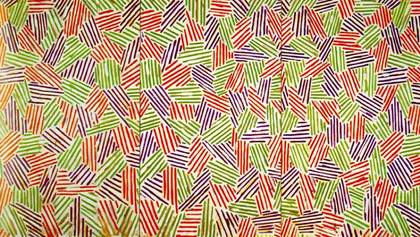
Fig.3
Jasper Johns
Scent 1973–4
Oil paint and encaustic on canvas
1829 x 3206 mm
Collection Ludwig, Aachen
© Jasper Johns
This paradox of the ‘three-in-one’ remains strictly unresolved in Untitled: no attempt is made to smooth over the divisions between the painting’s sections. Thus the motif returns, in Scent 1973–4 (fig.3), with all the force of an unsolved riddle, filling all three panels of the work with its jigsaw puzzle of orange, green and purple hatchings. The critic Thomas Hess was the first to report that the three panels of the painting are each divided into three vertical subsections, and that the pattern of hatchings in the subsections that abut each junction are identical, as are the hatchings in the first third of the left-hand panel and the last third of the panel at the far right. In other words, Hess writes, ‘if Scent were a sonnet, its rhyme scheme would be abc, cde, efa’;4 or if the three panels are understood to represent a ‘curved space’, as the author Michael Crichton suggests,5 each panel can be envisioned as a half-cylinder, partly overlapping the two others as they wrap around to form a tube.
Both writers offer clues to unpacking the structural logic of Scent without solving the mystery of its relationship to Untitled. A comparison of the two works yields both similarities and differences. The hatchings in both are painted in the secondary colours, suggesting that Scent represents an expansion or triplication of the first panel of Untitled. Conversely, it appears that with the suppression of the contents of the other panels in Untitled – the flagstones and casts – all figurative reference has been expunged in Scent. Yet what of the analogy between the three panels of Scent and the three stylistic divisions in Untitled? The latter work represents a kind of composite portrait of the artist’s oeuvre as captured at three moments in time, in 1955, 1967 and 1972 – each division representing a distinct stylistic shift or ‘pivot’ in Johns’s career, but also a moment when the sheer externality of an appropriated image or technique threatens to dismantle the stylistic unity and developmental continuity of his work. As such I would suggest that Scent represents an attempt to reassert this continuity by recasting the developmental series of Untitled as three successive views of an identical figure arrested in the moment of change.
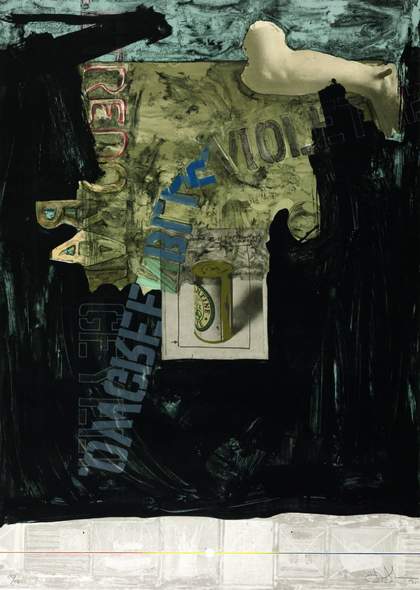
Fig.4
Jasper Johns
Decoy 1971
Tate P07380
Artwork © Jasper Johns
Photo © Tate
In order to understand this, it is necessary to re-examine Crichton’s argument that Scent represents a cylindrical or curved space. Noting that the repetition of hatchings on the left and right edges of Scent echoes the partial repetition of the letter ‘V’ at both sides of Voice 2 1971 (Kunstmuseum Basel, Basel), Crichton connects the ‘congruity of the extreme right- and left-hand borders of the painting’ in both works to the staggered composition of Johns’s Fool’s House 1962 (private collection).6 In this latter work, the stencilled letters ‘USE/FOOL’S HO’ at the top of the canvas suggest, according to Crichton, that ‘if the canvas which we see flat on the wall were actually curved in a cylinder, then the title letters would read continuously as one walked counterclockwise around the canvas’.7 Equally, such a compositional arrangement could suggest the possibility of elements ‘rotated about an axis’, as in Johns’s lithograph Decoy 1971 (Tate P07380; fig.4), whose repeating, frieze-like arrangement of photo-etchings of Johns’s painted bronzes and Sculp-metal works functioned, as Crichton wrote, as ‘a catalog of Johnsian imagery, a summary of many years of work’.8 Understood in this way, as the figuration of the artist’s catalogue or ‘corpus’, Decoy becomes a stand-in for the artist or his work, while the repeating frieze of sculptures can be read as a temporal sequence, connoting both change and recurrence, unity and development. This suggests an interpretation of both Decoy and Scent not imagined by Crichton: namely, that the possibility of axial rotation (or circumnavigation) be associated not with a geometric figure (the cylinder), but with a human figure – the figure of the artist in motion.
This becomes clearer if we observe an important difference between Scent and Voice 2. In the former, it is not merely the left and right edges of the image that repeat or overlap; instead, each of the painting’s three sections overlaps the two adjacent panels, while the left- and right-hand panels overlap one another. Accordingly, it is as if the three sections of Scent presented the viewer with three partly overlapping views of the same imaginary cylinder, rotated 120 degrees. If we imagine the three panels, not as three views of a rotating cylinder, but as three perspectives on a standing human figure turning on its axis, then the painting can be appended to a pictorial tradition dating back to antiquity, in which a grouping of three figures enables the artist to combine front, back and side views of a single model within the same image. Used in the ‘Revelers Vase’, the well-known sixth-century Attic red-figure amphora painted by Euthymides, the multi-figure motif is also associated with classical depictions of the Judgment of Paris and the Three Graces, as well as the circles of dancers depicted in works like Nicolas Poussin’s A Dance to the Music of Time c.1634–6 (Wallace Collection, London) and Henri Matisse’s Dance 1910 (State Hermitage Museum, St Petersburg). Often cited as proof of painting’s superiority to sculpture in that it enables the viewer to appreciate and compare all three sides of the human figure simultaneously, it emblematises the age-old competition or paragone between the two arts.9 (Johns’s sketchbook notes for Voice 2 include the instructions, ‘Have a silkscreen of Baudelaire’s description of sculpture as an inferior art.’)10 One of the most famous examples of its use in modern art is Matisse’s Bathers by a River 1909–17 (Art Institute of Chicago, Chicago), a work whose vertical divisions of the canvas surface suggest a close affinity to both Untitled and Scent.11
In this sense, the figurative associations absent from Scent continue to inhabit – or perhaps ‘haunt’ – the work’s compositional structure. With its implied division of the painting into three views of the same cylindrical figure, turning on its axis, Scent implicitly evokes the classical theme of the dancer – and at the same time, identifies this figure with the artist, whose stylistic ‘pivot’ in the leftmost panel of Untitled is here expanded and held up for contemplation. In Scent, the threefold division of Untitled becomes the three-sided view of a single figure in rotation, to emphasise the unity of the three phases within one oeuvre.12 Meanwhile, the stylistic and thematic shifts emblematised in the hatchings, flagstones and casts of Untitled are paved over by the stylistic unity of Scent, even as they are echoed – simultaneously represented and concealed – in the nearly imperceptible shifts in the materials used in each of the three panels of Scent: oil paint with varnish, oil on unsized canvas without varnish, and encaustic.13 Finally, as will be shown below, the hatching motif itself served as a metaphor for those stylistic ‘changes in direction’ that complicated Johns’s efforts to present a unified oeuvre. In this way, the hatchings also simultaneously represent and conceal the artist’s history of stylistic ‘pivots’, while casting into shadow the factors of artistic influence, collaboration and rivalry that lurked just beneath the surface of Johnsian appropriation and pastiche.
The ‘Pollock revival’ of the late 1960s
Johns’s work of the 1950s and 1960s had scandalised artists and critics alike by using dadaist irony and Duchampian paradox to demolish many of the favourite hobby-horses of modernist criticism: from the formalist doctrine that identified the essence of painting with ‘flatness’ to the romanticised image of the ‘American action painter’.14 By contrast, Johns’s crosshatch works struck critics as a belated embrace of painterly abstraction on the part of an artist better known for his critical deconstruction of abstract expressionism and its rhetorical claims. The critic Robert Hughes, for instance, wrote that without a knowledge of the new imagery’s sources, ‘one is left with a nice abstract design of hatch marks, beautifully rendered and otherwise unremarkable.’15 Interpreted in this way, as a foray into a purely non-objective abstraction, the crosshatchings seemed to mark Johns’s wholesale abandonment of the neo-dadaist devices that had characterised his work since 1954.
A convenient explanation for this apparent volte-face did not lie far from hand, however. Soon it was suggested that Johns’s sudden conversion to a mode of abstract mark-making closely associated with abstract expressionism – ‘all-over’ yet gestural, serialised yet expressive – testified to the artist’s belated engagement with the legacy of Jackson Pollock,16 an argument which seemed all the more credible in light of the impact of the Pollock retrospective mounted at New York’s Museum of Modern Art (MoMA) in 1967. This exhibition played a major role in the ‘Pollock revival’ of the late 1960s that is widely noted to have been a key influence on post-minimalism.17 Alongside a number of other factors, including the completion of the first doctoral dissertation on the artist’s work by Francis V. O’Connor in 1965,18 the show contributed greatly to the posthumous rehabilitation of Pollock’s reputation, which had suffered considerably in the final years of his personal and professional decline as he succumbed to alcoholism and artist’s block.
As if to clinch this argument, Johns’s titling of Scent matches the name that Pollock gave to one of the last two works he ever produced. Yet more than any other work, Pollock’s Scent 1955 (private collection) is emblematic of his late-career decline into blockage and self-doubt, its clotted, coagulated surface marking the abandonment of his signature drip-painting technique.19 In short, Scent seems a poor namesake for a work aiming to pay tribute to Pollock’s greatness.
Nor do the crosshatchings – considered from a purely aesthetic standpoint – so closely resemble Pollock’s high-volume painterly abstraction, as is claimed. In fact, the adjectives commonly used to describe them – hermetic,20 cerebral,21 lean22 – would seem to underscore the differences between the two artists, far more than their similarities. Indeed, in many ways they are less suited to the task than the gestural bravura of Johns’s works of the late 1950s and early 1960s, such as False Start 1959 (private collection).23
Finally, it might be observed that Johns had more to lose than he stood to gain from the popularity of the ‘Pollock revival’. By the early 1970s, the renovation of Pollock’s legacy had progressed to the point where it threatened to eclipse the significance of Johns’s epoch-making critique of abstract expressionism. This was especially evident in the work of three artists who had formerly numbered among the principal heirs to this critique: Eva Hesse, Robert Morris and Richard Serra.
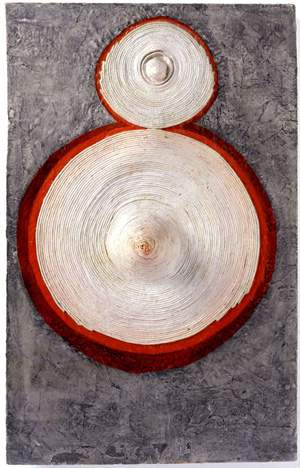
Fig.5
Eva Hesse
Ringaround Arosie 1965
Museum of Modern Art, New York

Fig.6
Eva Hesse
Untitled (Rope Piece) 1970
Whitney Museum of American Art, New York
© The estate of Eva Hesse; Hauser & Wirth Zürich and London
All three artists’ previous work attested to an intensive engagement with Johns (see, for instance, Hesse’s Ringaround Arosie 1965; fig.5) and, via Johns, with Duchamp’s use of language and the readymade.24 But whereas their early work espoused a typically neo-dadaist contempt for abstract expressionism’s macho histrionics and aspirations to transcendence, these artists’ newer bodies of work seemed rather to idealise Pollock, claiming him as a father figure for such vanguard artistic practices as installation art, earthworks and process art. The post-minimalist return to Pollock was manifested in works such as Hesse’s Right After 1969 (Milwaukee Art Museum, Milwaukee) and Untitled (Rope Piece) 1970 (fig.6), as well as the ‘open field’ works of Morris and Serra, including Morris’s thread waste works of the late 1960s.25 These were all linked to Pollock by their process-based installation techniques, their subjection of materials to the deformations of gravity and other entropic forces (such as scattering, pouring and mixing) and their adherence to a mode of dispersed or decentred pictorialism derived from Pollock’s ‘all-over’ drip paintings.
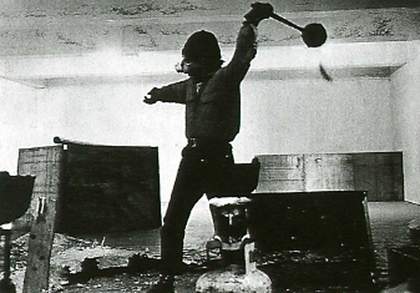
Fig.7
Gianfranco Gorgoni
Richard Serra throwing lead at Leo Castelli’s warehouse, New York, 1969
Photograph
In this context, even works that had originally been understood as critical negations of Pollock’s legacy came to appear more and more as acts of homage. For instance, in Serra’s series of Splashings and Castings, one of which Johns commissioned for his Houston Street studio in 1969–70, molten lead was scooped out of a crucible and hurled at the juncture between a wall and the floor. This created a lead ‘cast’ that recalled Johns’s own pioneering use of plaster and Sculp-metal casts, in which the expressive gesture of painterly abstraction was replaced with the mechanical imprint or trace. Subsequently, however, these works came to be known primarily through documentary photographs of Serra splashing lead at Castelli’s warehouse in 1969, which instantly called to mind the famous Hans Namuth ‘action photographs’ of Pollock at work (fig.7). Face obscured by respirator and goggles, arms outflung as he hurls molten lead from a ladle, in these photographs Serra literalises Harold Rosenberg’s famous description of the abstract expressionist canvas as ‘an arena in which to act’.26 Far from a critical negation of Pollock’s work, the Splashings came to appear as an act of identification or emulation – even an attempt to ‘out-Pollock’ Pollock himself.
It is therefore not surprising to find that in the wake of the Pollock retrospective, Johns began to draw a much clearer line between his work and abstract expressionism, renouncing the expressively dense and layered surfaces that had characterised much of his work of the 1960s in favour of the spare austerity of the crosshatchings. What is surprising, however, is that his newer work should make common cause with an artistic trend – conceptual art – for which he had previously shown little sympathy.
A change of direction: Sol LeWitt’s drawings and the death of the author

Fig.8
Sol LeWitt
Page from The Xerox Book 1968
Milton Glaser Design Study Center and Archives, New York
Drawing Series I, the twenty-four drawings Sol LeWitt created for art dealer Seth Siegelaub’s seminal 1968 book-as-exhibition The Xerox Book (fig.8), conforms to a single organisational plan: each drawing consists of a grid of sixteen squares; each square is filled with lines drawn in one of four directions, horizontal, vertical, diagonal left and diagonal right; and each sixteen-square grid is subdivided into four smaller grids of four squares each. The drawings’ structure emphasises the set of four line directions as the basic ‘module’ of the series; the series as a whole, meanwhile, systematically exploits every possible permutation of this module, so that no two drawings ever repeat the same configuration of line directions in the same quadrant of the page. In 1970 LeWitt elaborated on this basic schema by introducing line colour as an additional variable.27 He also began to publish drawings from this and later series in his own artist books, while adapting and extending the compositional methods employed in Drawing Series I to other media, including pen and ink drawings, prints such as Composite Series (set of 5) 1971 (Tate P07061–P07065) and his signature ‘wall drawings’, executed in pencil or crayon directly on the walls of galleries or museums.
Like LeWitt’s drawings, Johns’s crosshatch works are characterised by their reduction to a limited set of structural elements that are systematically varied, either alone or in combination.28 Specifically, both LeWitt’s drawings and Johns’s crosshatchings employ the same two basic variables: line direction and line colour. But the ‘systematicity’ of both groups of works – a characteristic specifically identified with conceptual art in seminal Artforum articles like Mel Bochner’s ‘The Serial Attitude’ (1967) or Jack Burnham’s ‘Systems Esthetics’ (1968) – goes far deeper.29 It is now clear that many, if not all, of Johns’s crosshatch works are also structured, like LeWitt’s, according to the organisational logic of the grid, their painted surfaces divided into larger units, or modules, whose system of arrangement can generally be reconstructed from close observation.
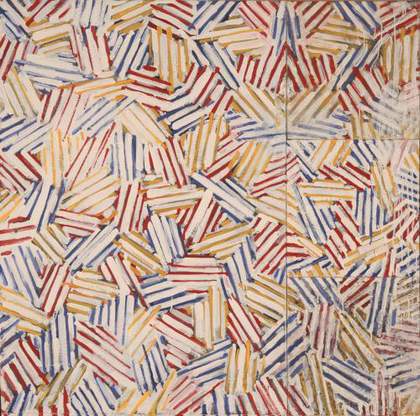
Fig.9
Jasper Johns
Untitled 1975
Oil paint and encaustic on canvas
1273.2 x 1273.2 mm
The Broad Art Foundation, Los Angeles
© Jasper Johns
Let us consider Johns’s Untitled 1975 (fig.9) – probably the work which most concisely summarises and condenses Johns’s engagement with LeWitt, establishing a formula that he would re-use in several later works, including the first version of Dancers on a Plane. The painting employs a square format that is made up of four panels, subdividing it into one large rectangle on the left and three smaller squares on the right-hand side, reminiscent of LeWitt’s division of a square grid into smaller squares in Drawing Series I. Yet it is the relationship between the hatchings in each of the abutting sections that most clearly reveals Johns’s system. As the writers Barbara Rose and Michael Crichton have discussed, each junction between panels – those where the three smaller panels meet, together with the junctions between each of the smaller panels and the larger, left-hand rectangle – reveals a different relationship between the hatchings on either side. Reading from top to bottom, five permutations are explored: 1) the hatchings mirror each other; 2) their colours and line directions change; 3) colours remain the same while lines change direction; 4) line directions continue but colours change; and 5) both colours and line directions continue without change.30 In this way, the work methodically explores every possible combination of variation and continuity in colour and direction, just as LeWitt’s Drawing Series I explored every possible four-fold division of a sixteen-squared grid into squares of differing line directions and, later, variations in colour.
In reacting against the ‘Pollock revival’ of the late 1960s and early 1970s, there is every reason to suppose that Johns might have taken a sympathetic interest in LeWitt’s wall drawings, with their audacious inversion of the conventions of modernist mural painting.31 On the one hand, LeWitt’s methodical approach to drawing offered Johns a means of critically distancing himself from the anti-compositional or ‘open field’ aesthetic embraced by Hesse, Morris and Serra under Pollock’s inspiration.32 On the other, affiliating his work with LeWitt’s enabled him to demonstrate the contemporary relevance of his art: even critics unsympathetic to what Peter Schjeldahl called the ‘increasingly arid climes’ of conceptual art acknowledged that it represented the cutting edge of the New York avant-garde.33
In short, Johns’s adoption of certain aspects of LeWitt’s drawing practice in the hatchings seems to have been motivated by his quest for an ally in the field of contemporary practice, or by a desire to align his work with trends that demonstrated the total impossibility of any naive ‘return to Pollock’. At the same time, Johns’s conjugation of his methods with LeWitt’s emphasises his own priority in pointing the way towards conceptual art, the basic characteristics of which – seriality, the use of language, permutation and the grid – had all been anticipated in his own work of the 1950s, most notably his alphabet and number paintings. Meanwhile, the irregular outlines of the individual ‘patches’ of hatchings recall the clustered, abbreviated brushstrokes of Johns’s paintings in encaustic of 1954–8, which make up what he has described as a ‘very complex set of corrections in relation to these lines [of the image or design]’,34 corrections which function by cutting across a line or cancelling it out. By recalling or recapitulating this technique, Johns’s crosshatchings of the 1970s and early 1980s emphasise that LeWitt’s systematic permutation of line direction from 1968 onwards ultimately derives from Johns’s work – and not the other way around.
Yet Johns might well have felt ambivalent about an alliance that cast LeWitt as his anointed successor, given that LeWitt’s rejection of traditional modes of authorship far exceeded his own critique of gestural abstraction. For Drawing Series I goes further than any previous artist’s work in bringing out the most radically anti-aesthetic implications of Johns’s early work – in particular, its serialisation of the abstract expressionist brushstroke. Where Johns broke apart the expressive unity and spontaneity of abstract expressionist gesture, replacing Willem de Kooning’s muscular slashes and Pollock’s dripping flows with an undifferentiated field of repetitive, stereotyped strokes, LeWitt’s ruled lines dispensed with both the artist’s hand and the expressive fluidity of paint. Furthermore, the system of permutation that LeWitt employed not only relieves the artist of any need to make compositional decisions; it also represents the complete set of instructions required for the re-creation of the work. By reducing the conceptual essence of the work of art to the verbal instructions required for its execution, LeWitt substituted the collectivity and communicability of language for the expressive individuality of the hand of the artist.35 In this respect, it is fitting that the first English-language translation of philosopher Roland Barthes’s essay ‘The Death of the Author’ was published in 1967 in Aspen, the very same journal in which LeWitt’s Serial Project no.1 (ABCD) had appeared the year before.36
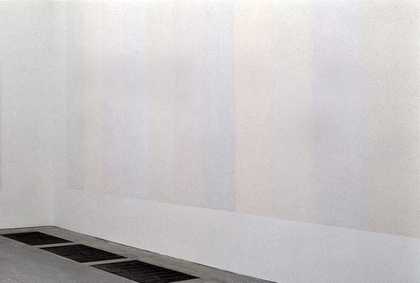
Fig.10
Sol LeWitt
A Wall Divided Vertically into Fifteen Equal Parts, Each with a Different Line Direction and Colour, and All Combinations 1970
Graphite on wall
Installation view, Tate Modern, London 2000
Tate T01766
© The estate of Sol LeWitt
Clearly, if Johns’s alliance with LeWitt was initially motivated by a desire to validate his own authorial prestige – which it effected by distancing Johns from Pollock while affirming the contemporary relevance of his work – he could never wholly sympathise with an artistic project that took the postmodernist death of the author as its principal point of departure. Perhaps Johns’s use of the complementary colours orange, purple and green in the first two works to feature hatching, Untitled and Scent, can be seen as symptomatic of this ambivalence. On the one hand, the idea of combining the primary colours in this way drew directly upon LeWitt, who had produced drawings like A Wall Divided Vertically into Fifteen Equal Parts, Each with a Different Line Direction and Colour, and All Combinations 1970 (Tate T01766; fig.10), in which each section features an overlay of lines in contrasting colours and directions, thus producing the fifteen possible combinations of the three primaries and black. On the other hand, this superimposition of the primary colours suggests itself as a metaphor for Johns’s own relationship to LeWitt: two artists whose styles, differing fundamentally in tone and orientation, could be combined to produce new colours and patterns, logics and affects – harmonious in some cases, clashing and dissonant in others.
One and many mistresses
Soon after painting Scent, the work’s triplicate division seems to have suggested to Johns an analogy with the surrealist game of ‘exquisite corpse’, in which a sequence of people each draw parts of a figure onto a piece of paper, which is folded each time to conceal the previous participant’s contribution. Produced in accordance with surrealist notions of automatism and objective chance, the result was typically a composite figure, illogical and often monstrous, analogous to the ‘chance meeting on a dissecting-table of a sewing-machine and an umbrella’ that characterised the surrealists’ visual experiments.37 In Corpse and Mirror 1974 (private collection) and Corpse and Mirror II 1974–5 (collection of the artist) Johns executed each of the three divisions himself, covering each one as it was completed, so that the new section would automatically yield a change in line direction; once the three registers were filled in, the completed canvas was then ‘mirrored’ in an adjoining panel mounted flush along its right-hand side.38 The mirror reflections create a strong impression of bilateral symmetry that reinforces the work’s evocation of a human body (the ‘corpse’). At the same time, insofar as this abstract mirroring suggests the modus operandi of the Rorschach blot and surrealist automatism’s reliance on psychological projection, it strengthens the work’s connection to surrealist techniques of collective authorship, permutation and inversion that represent both a precedent for and a counter-model to the deployment of these strategies in conceptual art.39
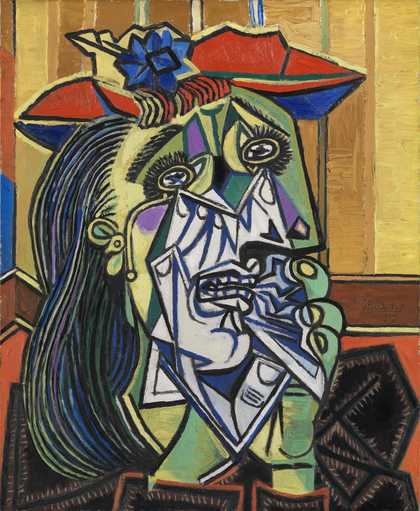
Fig.11
Pablo Picasso
Weeping Woman 1937
Tate T05010
Artwork © Succession Picasso/DACS 2016
Photo © Tate
If Johns’s growing discomfort with the conceptualist ‘death of the author’ led him to briefly embrace surrealism in his search for alternative strategies of compositional permutation and collaboration, both LeWitt and surrealism would be displaced in Johns’s 1975 works by a new metaphorical language, in which Johns’s artistic interlocutors are analogised to romantic partners or sexual surrogates. In 1974, with the legacy of surrealism still much on his mind, Johns saw Picasso’s 1937 etching Weeping Woman, from the Tate painting of the same name (Tate T05010; fig.11), at the print workshop Atelier Crommelynck in Paris; he would subsequently base the title of his Weeping Women 1975 (private collection) on this work.40 The subject of Picasso’s painting and print was partly derived from studies of weeping women he produced in the course of his work on his monumental Guernica 1937 (Museo Nacional Centro de Arte Reina Sofía, Madrid), but the figure of the weeping woman was also directly modelled upon Dora Maar, Picasso’s mistress from 1936 to 1943.41
Picasso’s death in 1973 confirmed critical judgements as to the essential unity of his oeuvre, notwithstanding his own frequently radical changes of style: this made him the perfect ally in Johns’s efforts to reassert the centrality of the authorial subject.42 Meanwhile, it is interesting to note that Johns’s Weeping Women, like Untitled 1972 and Scent, involves a three-fold division of the painting, which could be linked to the chronological position of Dora Maar, Picasso’s ‘weeping woman’,43 between the women who directly preceded and succeeded her in Picasso’s life: Marie-Therese Walter and Francoise Gilot. This sequence of ‘weeping women’ – as pluralised by Johns’s title – suggests a parallel between Picasso’s changes of mistress and Johns’s own abandonment of his prior attachments to conceptual art and surrealism.44 If, therefore, Scent equates the three-sided figure with an oeuvre simultaneously divided into phases and unified by a continuous movement or development – the image of the artist as dancer – then in Weeping Women this dance is reimagined as a pas de trois, suggesting an allegorical identification of Johns’s exchange of artistic ‘partners’ – surrealism for conceptual art, Picasso for surrealism – with the chronological succession of Picasso’s muses.
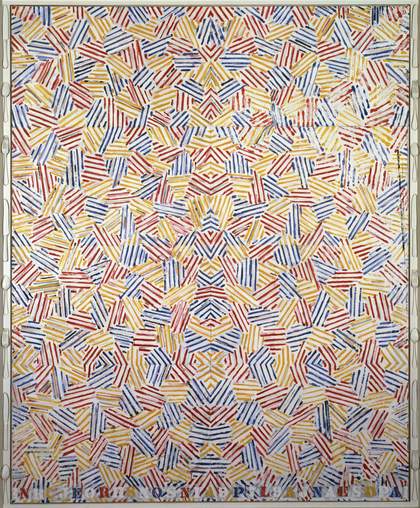
Fig.12
Jasper Johns
Dancers on a Plane 1979
Oil paint on canvas with objects
1978 x 1626 mm
Collection of the artist
© Jasper Johns
Painted in 1979, the first version of Dancers on a Plane (fig.12) cements this metaphorical linkage of artistic collaborators and dance partners. As Katherine Markoski details in this In Focus in her essay ‘Johns and Cunningham: Dancing on a Plane’, the compositional structure of the Dancers on a Plane paintings recalls the recurrence of elements in Merce Cunningham’s Exchange 1978/2013, the last dance for which Johns served as artistic advisor to Cunningham’s company. In this dance, Cunningham himself remained on stage throughout the performance while a group of newer members of his company were gradually replaced by a group of older members. The theme of continuity in change in Exchange, Markoski suggests, may have resonated with Johns’s meditations on the unity and consistency of his own art across time, something that would have been much on his mind following the opening of his retrospective at the Whitney Museum of Art, New York, in late 1977.45
The present essay has attempted to trace the roots of this self-reflective turn even further back in time, to the generational rupture between Johns and post-minimalism provoked by the ‘return to Pollock’ of the late 1960s and early 1970s. I interpret the hatching motif Johns adopted in 1972 as his countermove: with it, he emphatically rejected the spills, pours and dribbles erupting everywhere in the New York art scene of the 1970s, aligning himself instead with the system-driven conceptual art of Sol LeWitt. At the same time, the hatchings gave thematic expression to Johns’s concern with the overarching continuity of his art across time, analogising this and previous stylistic ‘pivots’ to the movements of a dance. As Johns in turn sought new models of continuity-in-change in the practices of surrealism and then in Picasso’s work, this figure of the pivoting dancer (or circle of dancers) gives way to the metaphor of the artistic partner as mistress or muse.
Yet while the evolution of this theme of continuity-in-change can be followed across its development and transformations in the crosshatch works of the 1970s, it does appear that the 1979 and 1980–1 Dancers on a Plane paintings marked a decisive turning point in his handling of the motif, in which his dissatisfaction with the conceptualist ‘death of the author’ finally came to a head. Compositionally, the 1979 painting can be seen as a summation of all of the techniques developed over the course of evolution of the crosshatchings, including the ‘corpse’ and ‘mirror’. Visually, the work is unified by the superimposition of the primary colours of the hatchings on a bright, white-painted ground. By comparing the hatchings to ‘dancers on a plane’, the painting analogises Johns’s frequent changes of artistic direction, his spontaneous embrace (and equally unpredictable abandonment) of his various ‘muses’, with the structural isolation and randomisation of the exchange of partners in Cunningham dance (as, for instance, in the dance Crises (1960), in which these combinations were determined by dice-throw).46
The 1980–1 Dancers on a Plane held by Tate features a nearly identical arrangement of hatchings, submerged in a darkened palette that combines grisaille with flashes of glowing colour, predominantly oranges, purples and greens. The vivid contrast between the chromatic tonalities and emotional textures of this painting as compared to the 1979 Dancers on a Plane is heightened by the unusual iconographic elements introduced in the 1980–1 painting, including the ‘testicles’ embedded in its lower frame. It is in this work, with its seemingly spontaneous, improvisatory use of colour, that the logical system controlling the hatchings collapses. Doubling down on the erotic implications of works like Weeping Women, meanwhile, the Tantric sources of Johns’s unconventional imagery present a startling counterpoint to the 1979 painting’s harmonious interweaving of influence and originality.
In considering the reasons that led Johns to abandon the systematic character of conceptual art, while simultaneously substituting a sexualised imagery of cosmic duality for the spatio-temporal unities of the dance, it should be noted that Cunningham’s recourse to chance operations, along with his strict separation of creative labour between choreographer, composer and designer, imply a decentring of authorship only slightly less radical than conceptual art’s. In this respect, it could hardly have provided a suitable model for Johns’s efforts to reaffirm the singularity of the artistic oeuvre. Moreover, if the optimistic handling of colour and composition in Johns’s 1979 Dancers on a Plane offers a fitting tribute to the success of his long-running collaboration with Cunningham, the darker emotional tenor of the 1980–1 work seemingly conveys both melancholy for the breaking of collaborative ties and a highly ambivalent cathecting of – a placing of emotional investment in – their meaning. Recast in the symbolic language of Tantric myth and mysticism, in which sexual and violent imagery conceals a deeper, transcendental truth, the aggressive and erotic underpinnings of creative partnership are brought to the fore, even as the redemptive potential of these impulses is suggested.
This may help to explain why, in his 1980–1 Dancers on a Plane, Johns turned for inspiration to the art of an esoteric religious tradition from the other side of the world. In contrast to the either/or of Western art historical concepts of originality and influence, Tantric art offered Johns a means of re-envisioning artistic exchange as a relation encompassing both oneness and duality, as is discussed elsewhere in this In Focus.47 In the Tate Dancers on a Plane, contradictions between stylistic change and the singularity of the oeuvre are mythically resolved in the figure of the Northern Buddhist deity Samvara and his divine consort, Vajrayogini, whose ecstatic couplings embrace all time and space within a cosmic unity unassailable by worldly difference. Moreover, this ‘master figure’ was no sooner framed than it raised additional difficulties for the negotiation of influence and exchange in Johns’s relations with Cunningham and other collaborators.
